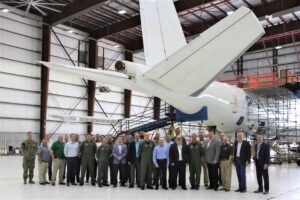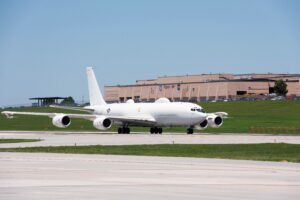The Navy recently accepted the first E-6B Mercury Take Charge and Move Out (TACAMO) upgraded by Northrop Grumman [NOC].
The E-6B aircraft acts as a communications relay and strategic airborne command post aircraft to execute the TACAMO mission that connects the president and Secretary of Defense with Navy nuclear ballistic missile forces during a crisis. It also conducts the Airborne Command Post mission that aids in the launching of U.S. land-based nuclear-armed intercontinental ballistic missiles via an airborne launch control system.

The Navy said Northrop Grumman performed the upgrades over the past year at its Aircraft Maintenance and Fabrication Center at Lake Charles, La.
Under a $11 million Integrated Maintenance and Modification Contract (IMMC) with the Navy, the company is directed to overhaul several E-6Bs by 2027. The IMMC covers six major modifications to improve their command, control and communications functions connecting the National Command Authority with U.S. strategic and non-strategic forces, dubbed Block II.
The Navy press release announcing the acceptance said the Block II work “will ensure the E-6B can successfully execute their mission for years to come.”
“The delivery of the first IMMC aircraft is a monumental achievement. We are delivering enhanced capabilities to the fleet quicker and ensuring they have the tools to successfully execute this critical mission for years to come,” Bob Stailey, the E-6B deputy program manager for the Airborne Strategic Command, Control, and Communications Program Office (PMA-271), said in a statement.
“An incredible amount of work went into this aircraft, which can now perform its nuclear deterrence mission better than ever. During the past year, the team that fielded this capability worked tirelessly to implement improvements to deliver the Block II capability with urgency,” Capt. Adam Scott, PMA-271 program manager, added.
Northrop Grumman is already conducting upgrades on the second Mercury aircraft.
Notably, the press release acknowledged the modification work is not yet on schedule.
The Navy said it is working with the company to get it closer to the contract’s required turnaround time of six months per aircraft “by implementing process improvements that span engineering, scheduling, management and production.”
The service noted this is the first time one company is responsible for the entire installation, which it argued will reduce bureaucracy and improve speed.
The E-6Bs are flown by Navy Fleet Air Reconnaissance Squadrons 3 and 4 under SCW-1 out of Tinker Air Force Base, Okla.

Following the delivery, pilots from SCW-1 picked up the plane on June 6 and flew it home to Tinker.
The E-6B is based on the Boeing 707 airliner, which replaced the previous EC-130Q TACAMO aircrafts in the early 1990s.
Last year, the Navy said it was working with Boeing [BA], Vertex Aerospace and the Oklahoma City Air Logistics Complex to replace corroded spar chords on the E-6Bs, an issue that was missed during previous E-6 service life extension. With life extension work, including the par chord fix, the aircraft’s service life was extended from 25,000 to 48,000 flight hours, allowing it to likely serve into the late 2030s (Defense Daily, Feb. 2, 2022).
Earlier this year, Northrop Grumman announced it was joined by Lockheed Martin [LMT], Raytheon Technologies [RTX] and the small businesses Crescent Systems and Long Wave to pursue the service’s new E-XX program for a new TACAMO fleet (Defense Daily, April 3).
The E-XX aircraft will be Lockheed Martin’s C-130J-30, selected by the Navy already while the service also chose a Collins low frequency radio system to be part of the program. Collins is a business unit of Raytheon.
The Navy currently plans for nine E-XX aircraft to replace the current E-6B TACAMO mission set, including three for engineering and manufacturing development. However, a Northrop Grumman official in April said the final number of E-XX aircraft is likely to be larger than those nine.